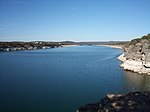


The Balcones Fault or Balcones Fault Zone is an area of largely normal faulting in the U.S. state of Texas that runs roughly from the southwest part of the state near Del Rio to the north-central region near Dallas along Interstate 35. The Balcones Fault zone is made up of many smaller features, including normal faults, grabens, and horsts. One of the obvious features is the Mount Bonnell Fault.
The location of the fault zone may be related to the Ouachita Mountains, formed 300 million years ago during a continental collision. Although long since worn away in Texas, the roots of these ancient mountains still exist, buried beneath thousands of feet of sediment. These buried Ouachita Mountains may still be an area of weakness that becomes a preferred site for faulting when stress exists in the Earth's crust.
The Balcones Fault has remained inactive for nearly 15 million years, with the last activity being during the Neogene period. This activity was related to subsidence of the Texas Coastal Plain, most likely from the large amount of sediment deposited on it by Texas rivers. The Balcones Fault is in one of the lowest-risk zones for earthquakes in the United States.
The surface expression of the fault is the Balcones Escarpment, which forms the eastern boundary of the Texas Hill Country and the western boundary of the Texas Coastal Plain, and consists of cliffs and cliff-like structures. Subterranean features such as Wonder Cave and numerous other smaller caves are found along the fault zone.
Many cities are located along this fault zone. Springs such as San Pedro Springs, Comal Springs, San Marcos Springs, Barton Springs, and Salado Springs are found in the fault zone and provide a source of fresh water and a place for human settlement.
The Balcones Fault Zone is a demarcation line for certain ecological systems and for species distributions, e.g., the California fan palm (Washingtonia filifera) is the only species of palm tree native to the continental United States west of the Balcones Fault.
See also
- Balcones Canyonlands National Wildlife Refuge
- Colorado River (Texas)
- Edwards Plateau
- Edwards Aquifer
- Texas Hill Country
References
- "Major Faults of the Edwards Aquifer". Edwards Aquifer. Archived from the original on 13 April 2010. Retrieved 11 May 2010. Edwards Aquifer
- Laubach, Stephen E. (1997). "Tectonic Map of Texas" (PDF). Bureau of Economic Geology, The University of Texas at Austin. Retrieved 30 July 2015.
- Grimshaw, Thomas W.; Charles Woodruff, Jr. (1986). "Structural Style in an En Echelon Fault System, Balcones Fault Zone, Central Texas: Geomorphologic and Hydrologic Implications". The University of Texas. Archived from the original on 2008-11-07. Retrieved 2008-10-27.
- Hill, Robert T. (1891). "A brief description of the Cretaceous rocks of Texas and their economic uses". In E. T. Dumble (ed.). First Annual Report of the Geological Survey of Texas, 1889. Austin: State Printing Office. p. 134. Archived from the original on 2010-06-21. Retrieved 2008-10-27.
- "Ouachita Mountains". J.S. Aber. Archived from the original on 2010-07-28. Retrieved 11 May 2010. J.S. Aber
- "Peak Acceleration (%g) with 10% Probability of Exceedance in 50 Years". United States Geological Survey. October 2002. Archived from the original (GIF) on 2007-06-27.
- Balcones Escarpment from the Handbook of Texas Online. Retrieved 30 July 2015. Texas State Historical Association
- "Balcones Fault Zone". UT Austin. Retrieved 11 May 2010. UT Austin
- Hogan, C. Michael (2009-01-05). "California Fan Palm: Washingtonia filifera". GlobalTwitcher.com. Archived from the original on 2009-09-30. Retrieved 2009-07-13.
External links
| Austin–Round Rock–San Marcos | |||||
|---|---|---|---|---|---|
| Central city |  | ||||
| Satellite cities | |||||
| Other communities | |||||
| Counties |
| ||||
| Parks and preserves | |||||
| Geography | |||||
| Bodies of water | |||||
| Transportation | |||||